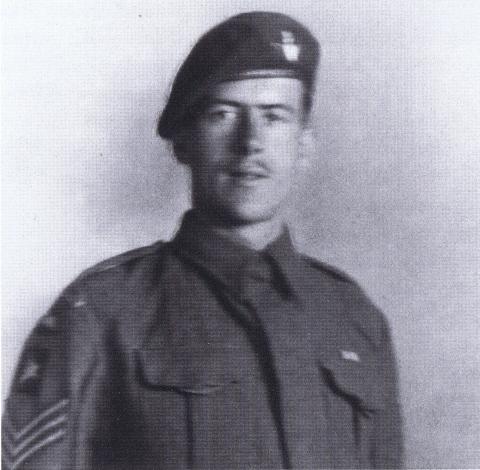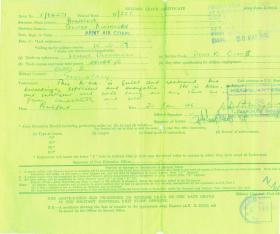George Humphreys was born in November 1920 in Gillingham. As a child he lived for a time in Wiesbaden, Germany, before living for three years Singapore during his early teens. He finally returned to the UK in the mid-1930s.
George was keen to join the Army and lied about his age (he was just 16) to the Recruiting Sergeant at Aldershot when he enlisted. His initial service was with the Royal Army Service Corps for five years from 1937, through to 1942. He had been deployed to Egypt shortly after joining up. He gained a reputation as a good shot, and was credited with bringing down a ME110 fighter with small arms fire near Ajdabiyah in Eastern Libya, whilst attached to the 7th Armoured Division early in the war.
It was whilst still in the Middle East that he first encountered Airborne Forces. Though he was then a Driver attached to 151 Field Ambulance RAMC, and enrolled on an Officer Cadet training course, he subsequently decided to become a parachutist after watching a parachute demonstration.
Shortly afterwards he joined the renumbered 156 Battalion, and within six months had been promoted to Sergeant with A Coy, 156 Parachute Battalion. He served in Italian campaign before the majority of 1st Airborne Division returned to the UK. Whilst stationed at Sandy Lodge billet, near Grantham, he met a young Margaret Roberts (later Thatcher, the first female Prime Minister of Great Britain), although their relationship was cut short when he was sent on exercise.
After many training exercises and cancelled operations Sgt Humphreys finally emplaned for Arnhem, on 18 September 1944, during Op Market Garden as a Section Commander in 5 Platoon. After landing, his introduction to the ensuing battle was swift.
On Tuesday 19 September, several in his section received a direct hit (probably from a Mortar) during an advance on a German position, killing several, whilst others (including Sgt Humphreys) were wounded or stunned by the blast. Shortly afterwards, still concussed and semi-conscious he was left for dead by a group of passing Germans, before he managed to crawl to cover. Shell-shocked and disorientated, he was fortunate to meet two other Airborne soldiers at some point during the following days and returned with, with the help of a Dutch local under cover of darkness to finally rejoin the rest of 156 Battalion at Oosterbeek on Friday 22 September.
During the fighting on the 1st Airborne defensive positions (later known as a the Oosterbeek Perimeter) Sgt Humphreys dug up couch grass (remembering tasty bamboo shoots he had tried in Singapore) and collecting rainwater as basic supplies ran perilously low. The Battle was particularly ferocious in his section of the Perimeter. He recalled:
'On the northern edge of the Perimeter the rest of the Division and relief appeared a long way off. It seemed to be a private war between us and the Germans - a battle of attrition. You were no longer a normal person - more like an animal. It was survival, just food and killing, permanently on alert. Every sound could mean danger. It was like a nightmare. All the refinement of civilisation vanished.[...]
When you shot a German he was just a target. You were a trained marksman and you did your job [...] It was [only] later, when I had time to the think, that remorse took over and I thought that some of those Germans could have been the children I played with as a child in Wiesbaden in Germany'
After continuous fighting for the rest of the Battle, he was one of the few from 156 Battalion to escape across the Rhine at the end of the Battle during Operation Berlin. He recalls the last desperate moments of the escape across the Rhine:
'I remember the noise from their guns and our guns, the cracking of bullets, some ricocheting off hard surfaces, other thudding into the bank to close to comfort. Moving on, we tried to climb a flood bank and normally we would have raced up such a small hill, but our condition was far from normal. Kicking my boots sideways into the mud, I managed to get some purchase and, when I reached the top, I just let myself slide down the other side. Others followed. Shells and mortars still exploded on the south bank, but as we lay motionless for a moment behind that protective earth screen, we rejoiced - we had made it.'
On his return to the UK in late 1944, he was became part of the reformed 1st Parachute Battalion, in R Company. In early May 1945, he flew to Denmark to 'forestall the Russians' and assist in the disarmament of the German forces in the region.
After the war however, his service career was approaching its end. He was demobbed in February 1946, and joined the Reserve of the Royal Army Ordnance Corps, taking a job with an engineering company. During the late 1940s, several other engineering jobs followed before he took a position as a Joint Managing Director to an engineering firm, with whom he moved to the South West with his first wife and children.
Later in 1972, now married to his second wife Carmen, he went into health care and eventually worked at a hospital in Bodmin, before retirement to Falmouth in 1983 (where he still lives).
Further reading
John O'Reilly, 156 Parachute Battalion: From Dehli to Arnhem (2009), Thoroton Publishing.
With assistance from George Humphreys
Read More



Latest Comments
There are currently no comments for this content.
Add Comment
In order to add comments you must be registered with ParaData.
If you are currently a ParaData member please login.
If you are not currently a ParaData member but wish to get involved please register.